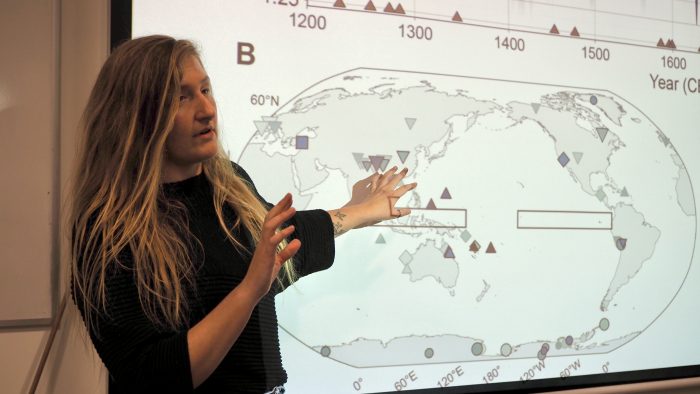Jonathan Brown with Centre researchers.

Researchers have found the atmospheric flow around the Pacific Ocean (the Pacific Walker Circulation) has changed, with important implications for El Niño and La Niña events.
“After Australia saw severe flooding and rainfall from a rare 3 year La Niña event, our research has found that one of the key drivers of these events is changing, with slower transitions between La Niña and El Niño events” says Dr Georgy Falster, Research Fellow at the ARC Centre of Excellence for Climate Extremes.
“That means in future we could see more of these multi-year La Niña or El Niño events as the atmospheric flow above the Pacific Ocean switches more slowly between La Niña and El Niño phases” says Dr Falster.
The research, published today in Nature, used global data from ice cores, trees, lakes, corals and caves to build a picture of how the Pacific Walker Circulation has changed over time.
Dr Falster began this research whilst working as a Postdoctoral Research Associate at Washington University in St. Louis.
“The Pacific Ocean is one of the most important aspects of global climate and weather – largely due to its size. What happens in such a huge ocean has wide ranging impacts all across the globe” says Dr Falster.
“If atmospheric circulation over the Pacific Ocean changes that has major impacts on the weather we experience across the entire planet. Human-caused changes to the Pacific Walker Circulation could mean we experience El Niño and La Niña, and the risks associated with them, for longer periods. Multiple years of El Niño and La Niña could become more common”
The researchers say humans are impacting climate systems like the Pacific Walker Circulation, but not in the ways they expected.
“We set out to find out whether greenhouse gases had affected the Pacific Walker Circulation. We found that the overall strength hasn’t changed yet, but instead, the year-to-year behaviour is different” says Dr Falster.
“Ultimately, we know the planet is warming and that warming is caused by human induced greenhouse gases. To plan and adapt for the impacts of climate change, we need to improve our knowledge of climate systems across the board. We need to know how the Pacific Walker Circulation is responding to global warming so we can help communities prepare for potential periods of flood, drought, rain and fire.”
International collaboration helps us to understand the Pacific Walker Circulation

This research, funded by the US National Science Foundation and the Australian Research Council Centre of Excellence for Climate Extremes was an international collaboration with Falster’s co-authors at Washington University in St Louis (Dr Bronwen Konecky), University of Hawaii, Manoa (Dr Sloan Coates), and the University of California, Santa Barbara (Associate Professor Samantha Stevenson).
For Dr Falster, the research relied on the contributions of scientists all around the world.
“Even if there’s just a little bit of information stored up in an ice core from Antarctica or a tree from China, we can extract that and use that to help us figure out how the Pacific Walker Circulation has changed. I take many datasets that have been produced by different scientists all over the world, over many years, and put those into a big pool of data to see what new things I can pull out” says Dr Falster.
Dr Bronwen Konecky says the researchers faced challenges regarding the techniques available to conduct the research.
“Using our proxy data, we’ve now reconstructed the Pacific Walker Circulation now going back to the year 1200″ says Konecky.
“A major problem we faced was choosing the best statistical technique to build out the reconstructions. So we decided, why pick just one? Instead, we used as many as we could. We’ve calibrated these reconstructions using modern datasets of atmospheric pressure at sea level. By using multiple approaches, we know that our results are robust beyond the error bars of just one statistical tool.”
The research is particularly important for the future of communities across the Pacific.
“Our study provides a long-term context for a fundamental component of the atmosphere-ocean system in the tropics,” says Dr Sloan Coats.
“Understanding how the Pacific Walker Circulation is affected by climate change will enable communities across the Pacific and beyond to better prepare for the challenges they may face in the coming decades.”
Associate Professor Samantha Stevenson says the research will play a role in the future of reliable predictions.
“If we don’t know what happened in the real world, then we don’t know if the models that we’re using to project future changes, impacts and risks are giving us the right picture” says Stevenson.
The research is published in Nature.
